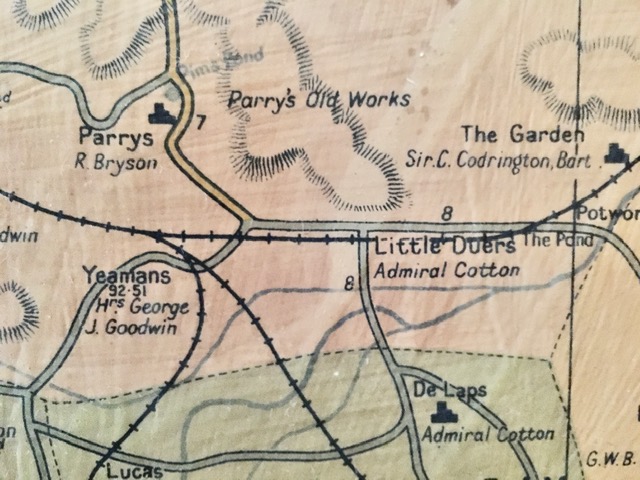About
Type: Ruin
Parish: St.Peter
Founding date: 1770
See on Google Maps!

Current Status
In later years Little Duers was used as a collection yard for the surrounding cane fields. The cane was collected by bullock cart, later lorry and tractor, and stacked to transferred later by locomotive to Gunthorpes Sugar Factory. On the road can still be seen the remains of a small hut once part of this operation.
Nearby estates were Yeamons (#91) and Big Duer’s to the west, Parry’s (#88) to the north and Delap’s (#137) to the south. Potworks Dam flooded a large part of the acreage from this estate. The area was fertile and flat which made it ideal for planting sugar cane.
Estate Related History/Timeline
The 1777-78 map by John Luffman shows that there was a mill at this site.
John Duer inherited as an infant in 1783 on the death of his father John Duer under the will of his grandfather, also John Duer.
T71/1220: Abstract of indenture dated 14/02/1812 between John Dixon Esq., Capt. In Her Majesty’s Royal Navy, and Benjamin Aislabie, of the Minories, assigning the plantation referred to as ‘the Little’ as security for mortgage. Benjamin Aislable assigned it to Manning and Anderdon. There is also a reference to a mortgage for £1,000 by Sir G.H. Rose to Mannings 29/05/1820.
T71/1220: Counterclaim by Charles John Manning, dated 01/12/1829; indenture registered in Antigua 17/4/1830 made between GHR, W.S Rose, Frances Theodore Rose and Charles John Manning; Little Duers conveyed to Charles John Manning. The name of Charles John Manning used by Manning and Anderdon as trustee in purchase, estate and slaves ‘conveyed to the said Charles John Manning without his knowledge or consent.’
After Manning and Anderdon’s bankruptcy, creditors brought a suit vs. Charles John Manning in Antigua for supplies. Legacies of British Slave-ownership.
T71/1220: Counterclaim by Charles John Manning, dated 09/12/1829: Indenture registered in Antigua 17/4/1830 made between GHR, W.S. Rose, Frances Theodora Rose and Charles John Manning; Little Duers conveyed to Charles John Manning. The name of Charles John Manning used by Manning and Anderdon as trustee in purchase, estate and slaves conveyed to the said Charles John Manning ‘without his knowledge or consent’. After Manning and Anderdon’s bankruptcy, creditors brought a suit vs. Charles John Manning in Antigua for supplies.
1829: In 1829, this estate contained 140 acres and 69 slaves.
1843: In 1843, when owned by William Lee contained 140 acres.
1878: In 1878, when owned by W.A. Parker & Co. consisted of only 44 acres. They also owned Hawes and Mercer’s Creek, Big Duer’s and Little Duer’s and Lower Freeman’s.
William Lee is listed in the Slave Register with names of the slaves he owned.
In 1875 records in the Archives state that “Robert Potter, Planter, was of ‘Little Duers’ and on Dec. 21, 1909, a labourer on ‘Little Duer’s Estate’ was married.
Lord Combermere age 73, was visiting London when he was run over by a horse drawn carriage, seriously injuring both of his legs. He appeared to be recovering well six weeks later when a blood clot formed and the sturdy old man passed away fairly suddenly on December 1, 1891. There is also a rather interesting story about Lord Combermere’s Ghost – an apparition that appeared on a photograph taken in 1891 at Combermere Abbey by Sybell Corbet.
“It was at Little Duer’s that the Goodwin boy child used to go to have a good time.” Selvyn Walter.
Enslaved People’s History
Based on contemporary research, we have little information to share about the enslaved peoples from this plantation at this time. We do know that the estate contained 140 acres and 69 enslaved people in 1829, and that 73 enslaved people were later liberated for the sum of £889 10 s 1 d after slavery was abolished in the Caribbean. We will continue our quest for more information about these vital individuals.
Legacies of British Slave-ownership: Antigua 257 Little Duer’s. Awarded £889 10 s 1 d for 73 enslaved.
Awardee were John Dixon,and Neville Reid. Benjamin Aislabie, Francis Theodore Rose, Sir George Henry Rose and William Steward were ‘other association’ and Charles Ridge, William Lee, Charles John Manning, Elizabeth Grace Duer and Frances Duer were unsuccessful. John Duer was listed as Previous Owner.
Ownership Chronology
- Ownership John Duer d.1716
- 1770: John Duer
- 1780: Rev. Roland Duer
- 1783: John Duer (Died 1822) 1777/78 Luffman map
- 1822: Heirs of John Duer
- 1830: Charles John Manning
- 1852: William Lee.
- 1870: Estate of William Lee (dec.)
- 1872: Heirs of William Lee 1872 Horsford Almanac
- 1878: W.A. Parker & Co. total of 44 acres. This company left Antigua by 1881
- 1881: Lord Combermere (1818-1891) Henry Stapleton Cotton, second Viscount Combermere
- 1933: Admiral Sir Charles Cotton 1933 Camacho map
- 1941: The Antigua Syndicate Estates
- 1968: Antigua Government – Crown Land